2.1 Fill in the details leading to Eq (2.17) and use it to find the weighted residuals formulation of Example 2.1
Solution:
a) dx ck = 0 (Eq.l.U)
Integration by parts:
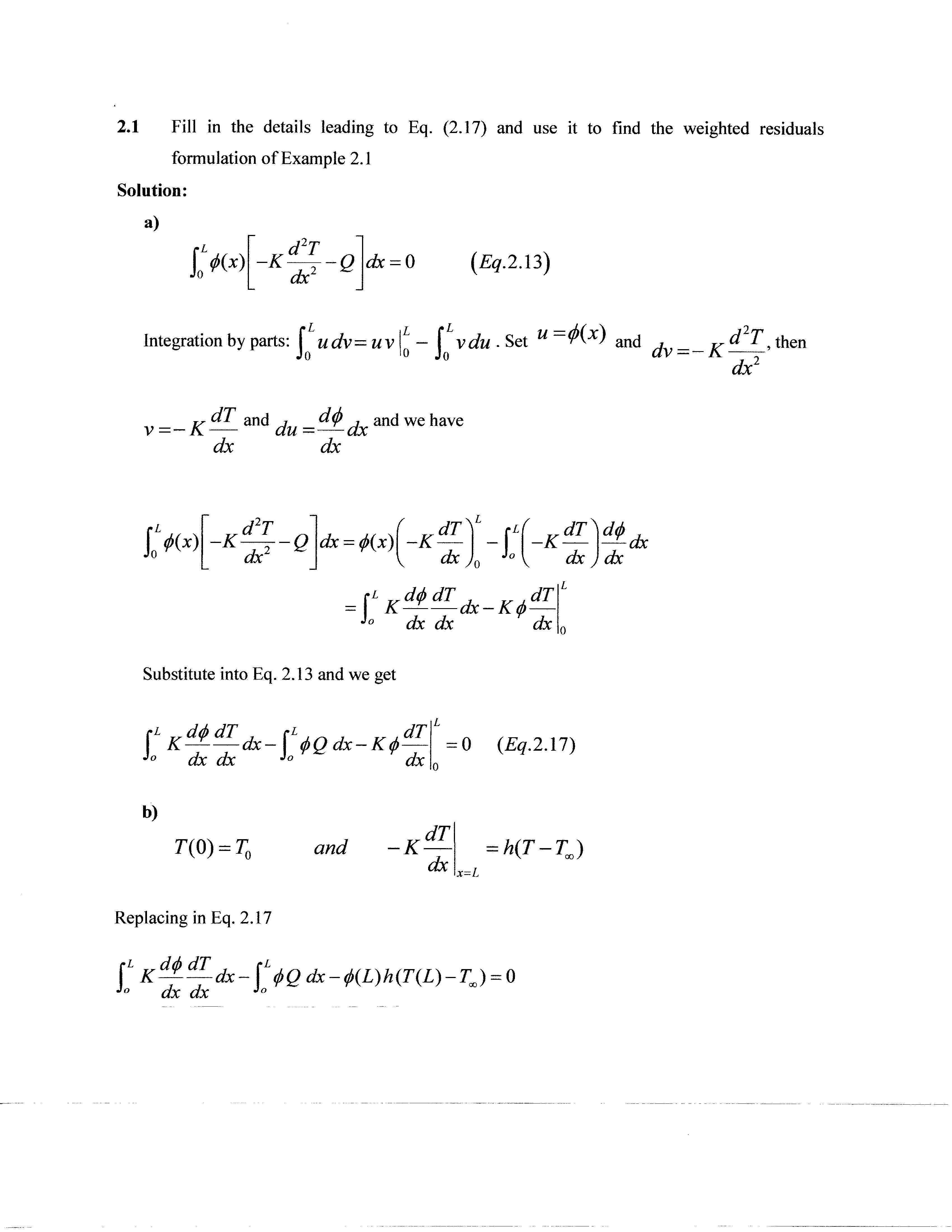
Substitute into Eq.2.13 and we get
Replacing inEq. 2.17
2.2 Use Eq (2.17) to find the weighted residuals formulation of Eqs (2.1) the heat flux q.
Solution: - (2.3) in terms of
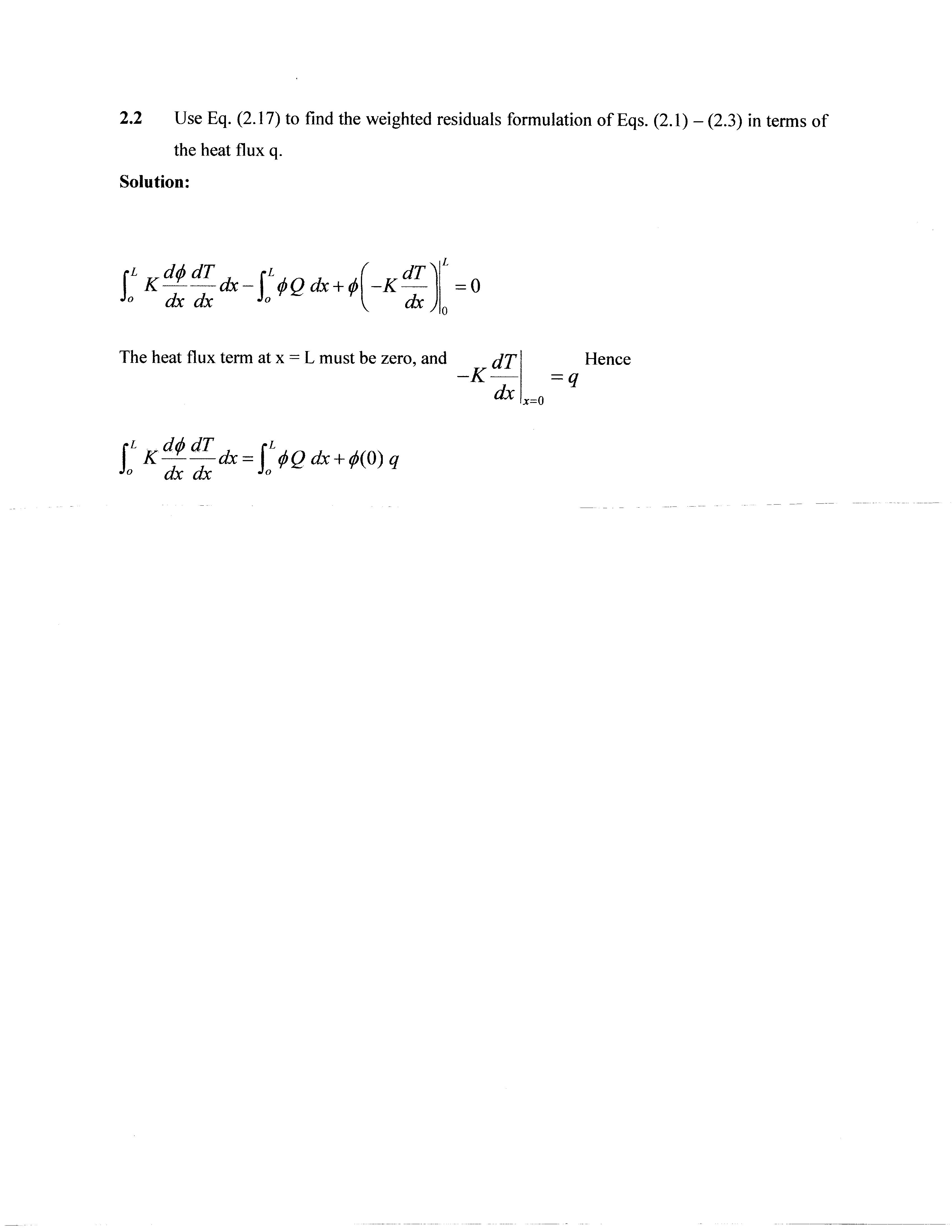
cL ^d(l>dT K •''^ dx dx rL dx- ^Qdx + ^ -K dT_ dx = 0
The heat flux term at x = Lmust be zero, and dT -K dx Hence x=Q
L ^dldT^^^^ fi^ ^ dx + ^(0) q ^ dx dx •'^
2.3 Obtain expression (2.30).
Solution:
The weighted residuals form for the second term is >(X) dx = 0
After integration by parts on the first term
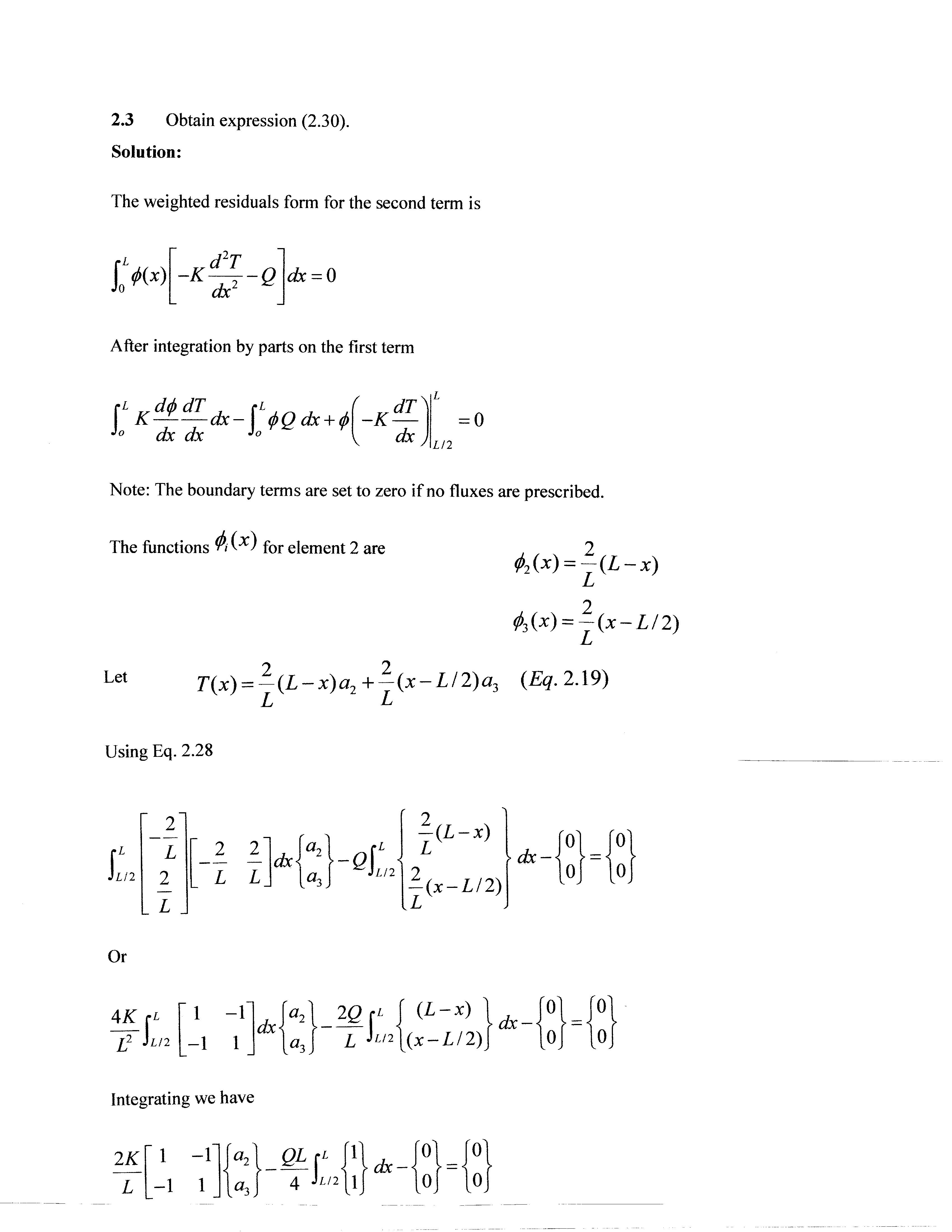
Note: The boundary terms are set to zero if no fluxes are prescribed
The functions for element 2 are
Integrating we have
Consider the equation + w + x = 0, 0<jc<l with w(0) = u(l) = 0 Assume an approximation for u{x) = i(x) with ^(x ) = x(l -
The residual is R{u, x) - -2a^ + a, - x)] + X and the weight Wi{x) = (j) \{x) = JC(1 - x). Find the solution from the following integral

.Solution:
W{x) R(u, x)dx= x(l - x)(-2a^ + a^x(l -x) + x)dx = 0
Or rl
0 W(x) R(u, x)ck= ^ (-2a^x +(3a, + l)x^ - 2a^ + l)x^ + a^x"^)ck = 0 -a, 4--(3a +l)--(2a, +l) + - a =— + —= 0
Compare with the exact solution given by u (x) X sinl
Evaluating at x=l/2 u{VI7) — 0.069444 ^^^^ "^^^^ error w*(l/2) = 0.069747
2.5 Use the weak statement formulation to find solutions to the equation dx" w(0) = 0, = 1, 0<jc<l du dx
(a) Using linear interpolation functions, as explained in Section 2.3, use (i) one element and (ii) two elements.
(b) Using simple polynomial functions that satisfy the boundary conditions at the lefthand side, i.e.,
(i) u(x) = a\x, hence ^ i(x) = W\{x) = x
(ii) u{x) = (afix+a2X^, hence (f>\{x) = Wx{x) = x,
(l>2{x)=W2ix)-^x\
(c) Using circular functions that satisfy the boundary conditions at the left-hand side, i.e.,
(i) u{x) = a/ sin (n/2Lx)
(ii) u{x) = «ysin (n/2Lx) +aa2 sin (3n/2Lx)
(d) Find the analytical solution and compare with results from (a),(b) and (c).
Solution
a) The residual function is ]^(u^x) = ^ +1 The weak form after integration by parts is dx^ f dW du ^ dxdu + W -W — Jo ^ dx dx J dx = 0

One element solution u{x) = (l-x)^ ! +X<32
Two element solution Element 1:

Element 2
^2=2(l-x ) ^3-2(x-l/2 )
- 2 0 " -1/4^
2 4 - 2 < «2 -1/ 2 >
- 2 2 _ 3/4
and a^=lf2 u(x) = 3x- l x/ 4 0<x<l/ 2 l/2<x< l b)
Using polynomials i) ^j= x u[x) = a^x (la^ + x)dx-l = 0 , a^=\l2 , i/(x) = x/ 2 , same as using one element ii)
^i- x , (l>2=x^ ' u{x) = a^x + a2X^ For W=^ | r [1 • (<3i + 2«2^) + - 1 = 0 rir For W=^2 Jo • (a, + 2a2x) + x^ k/x - 1 = 0
The system becomes ^1 +^2 =1/2 4 ai + —^9 =2/3 or c)
Using circular functions i) ^} = sin X v2 J , u {x) = ai sin X
2
j
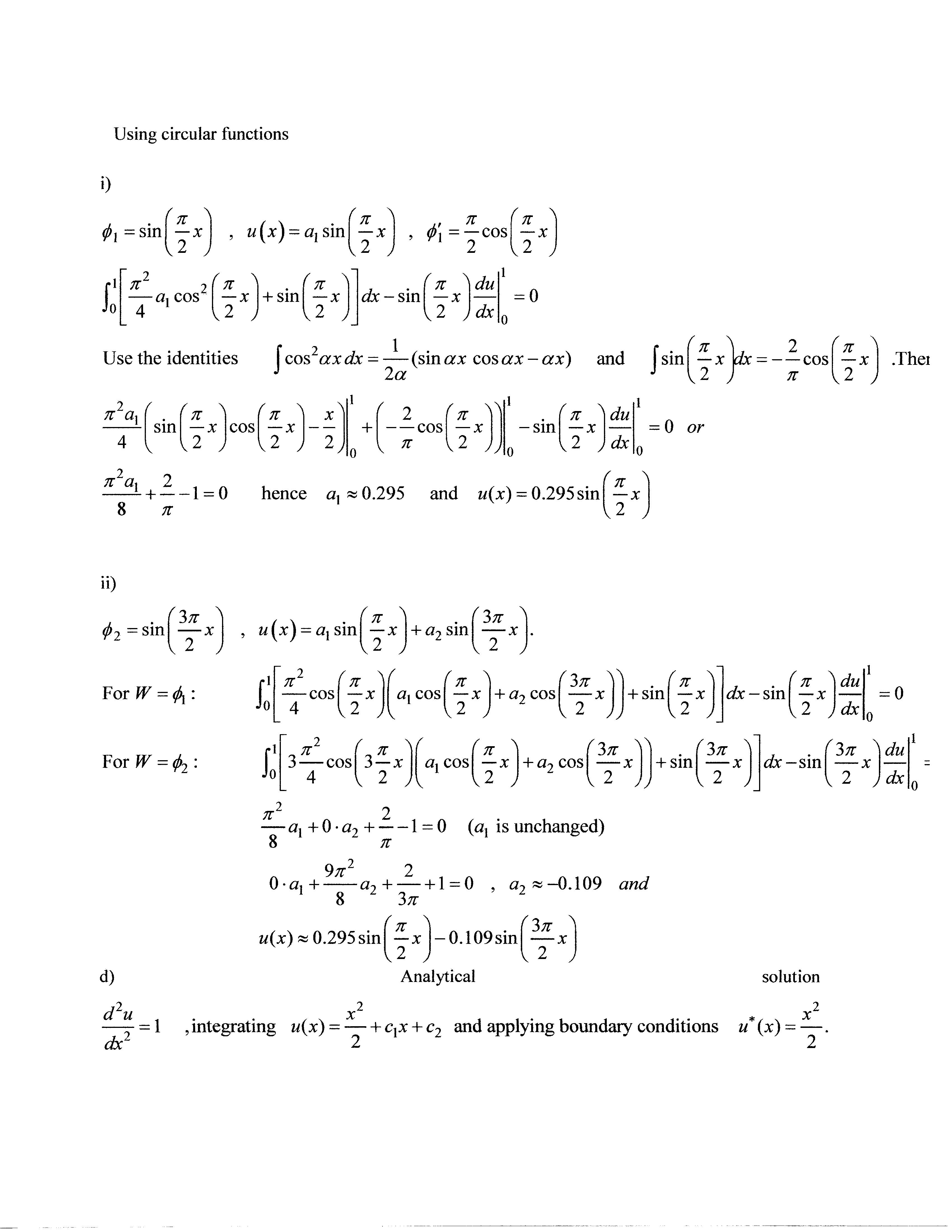
^ 2 = sm
For r = ^ : For r = ^2 : X
hence a, » 0.295 and M(X ) = 0.295sin X V2 J
flfj+ 0 • (32 H 1 = 0 (aj is unchanged) 8 n 97r^ 2
0-a, + — + 1 = 0 fl2~-0-109 and ^ 8 ^ 3;r ^ w(x)« 0.295sin -0.109sin X

Notice that all the approximations are exact at x = 1/2, and the Galerkin approximations using x 2 and X both yield the exact solution Also notice that the boundary condition at x = 1 is satisfied only approximately. In case a), the first solution gives ^ dx i . and the second solution gives 2
2.6

Subdivide the interval 0 < x < Z into 10 linear elements, construct the element equations for four consecutive elements starting with element four, and show that none of the parameters aj is related to more than two additional parameters in the equations. The only ones involved being ai-i and a,+] (as a consequence of this, the final system of linear equations will involve a tri-diagonal matrixwhich is easy to solve)
Solution:
For an element e^^ ={x/Xj^ <x<Xi^_^_^) the element stiffness matrix is obtained from r^k+'i ^ . Allthe stiffness matrices must be equal, so let's calculate the first dx dx
and after assembling
Note that each equation / involves only three unknowns and a^^^, so the stiffness matrix is tri-diagonal.
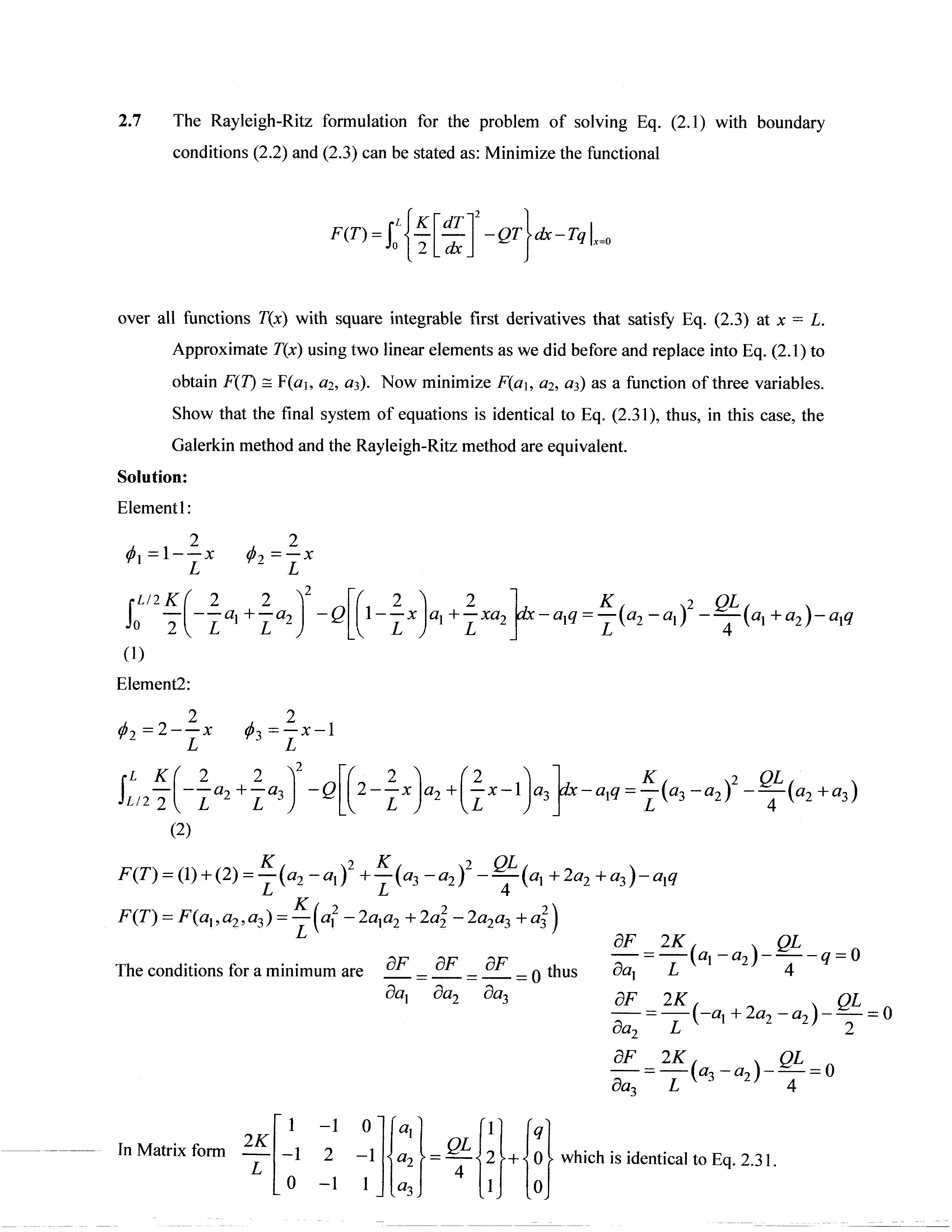
2.7 The Rayleigh-Ritz formulation for the problem of solving Eq (2.1) with boundary conditions (2.2) and (2.3) can be stated as: Minimize the fiinctional F{T) = £ 2 dx -QT\dx-Tq .t=0
over all functions T{x) with square integrable first derivatives that satisfy Eq (2.3) at x = Z
Approximate T{x) using two linear elements as we did before and replace into Eq. (2.1) to obtain F{T) = F(«], ai, a^). Now minimize F{a\, a^, ai) as a function of three variables
Show that the final system of equations is identical to Eq (2.31), thus, in this case, the Galerkin method and the Rayleigh-Ritz method are equivalent.
Solution:
2.8 Let us consider once more Problem 2.3 above. Assume that w(x) = aix^ and Wi(x) = x^, but this time use Eq (2.11) and proceed as in Problem 2.2 in order to obtain a solution
Show that this solution is identical to that obtained in Problem 2.3(b)(ii), and hence, the process of integration by parts does not introduce any changes
Solution:
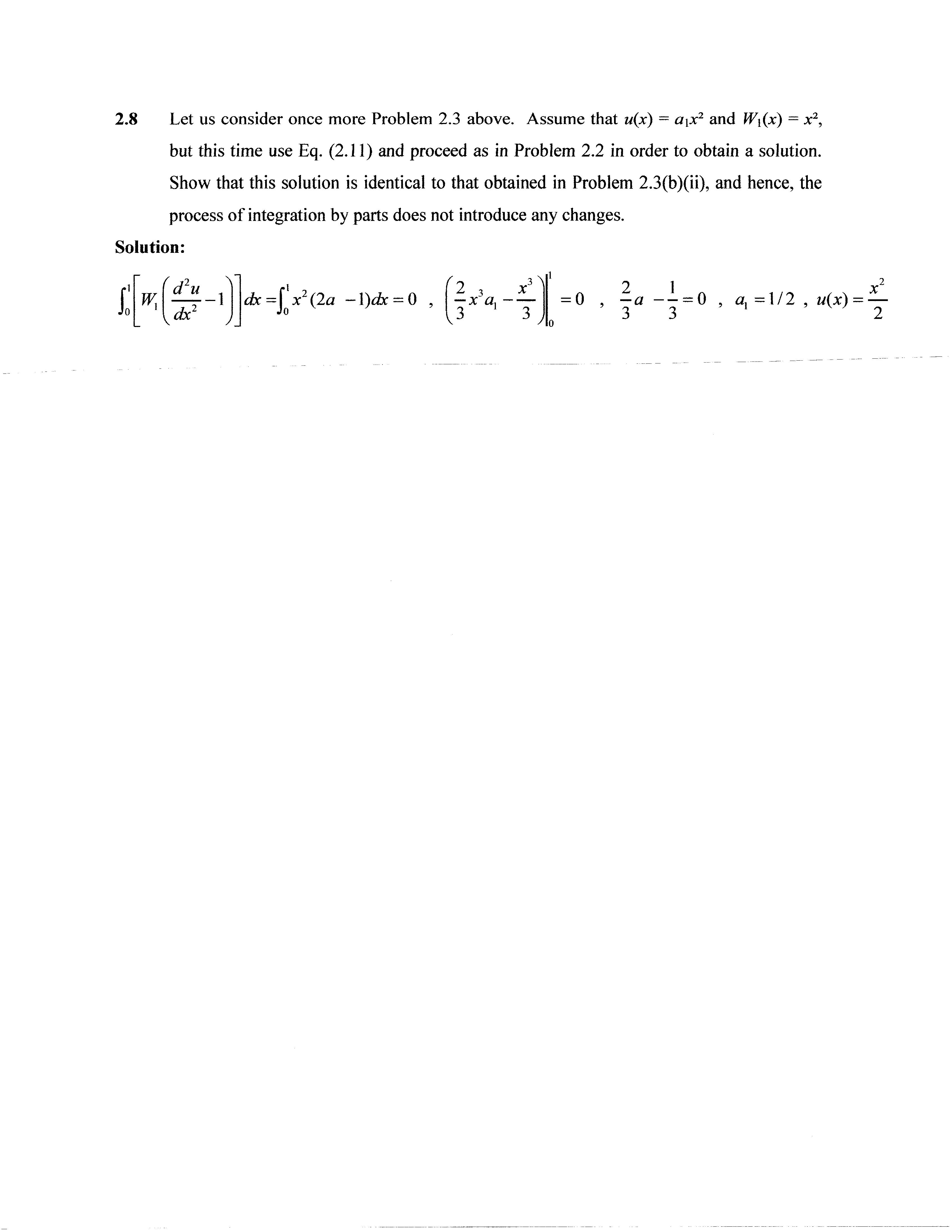

2.9 Inexample 2.2, first find the exact analytical solution, then calculate two more Galerkin approximations using Solution:
The analytical solution is ^dWdu ii(^x) = —{^x-x^y The Galerkin approximation is dx dx -W dx = 0'
u(x) = (3]sin ;rx + sin 27tx , = sin TTX , sin ITTX
a) rl oL 0 cos TTxf^a^ cos TTX + laj cos2;rx) - sin nx dx = 0 ITV^ cos Inx cos nx + 2a2cos Inx) - sin 2-;rx tir= 0 or fli+0-a2 = 0 , a^= — u{x) - — sin;rx n , <3«flf 0•^1 + 2:7r ^2+0 = 0 ,
b) M(x)= aj sin:;rx+ a2sin2;7rx + a3sin3:7rx , fPj=sin;rx , W^^^VCLITIX , H^=sin3;Tx
We only needtocalculate , and remainthe samedue totheorthogonality ofthesine functions : 3;r^cos3;rx(fl} cos ;7rx +2^2 cos2;rx4-3(33 cos3;rx)-sin 3:^x r 2 ' 3;r ' Tin" , W3(x) = — 3;r'* 1 sin ;rx + — sin3;rx 27
2.10 Derive Eq. (2.32) from Eq. (2.31).

Eqs 2.32 j£+0 L , -a,+2a^ =
substituting into the first equation = ^ + ' K IK
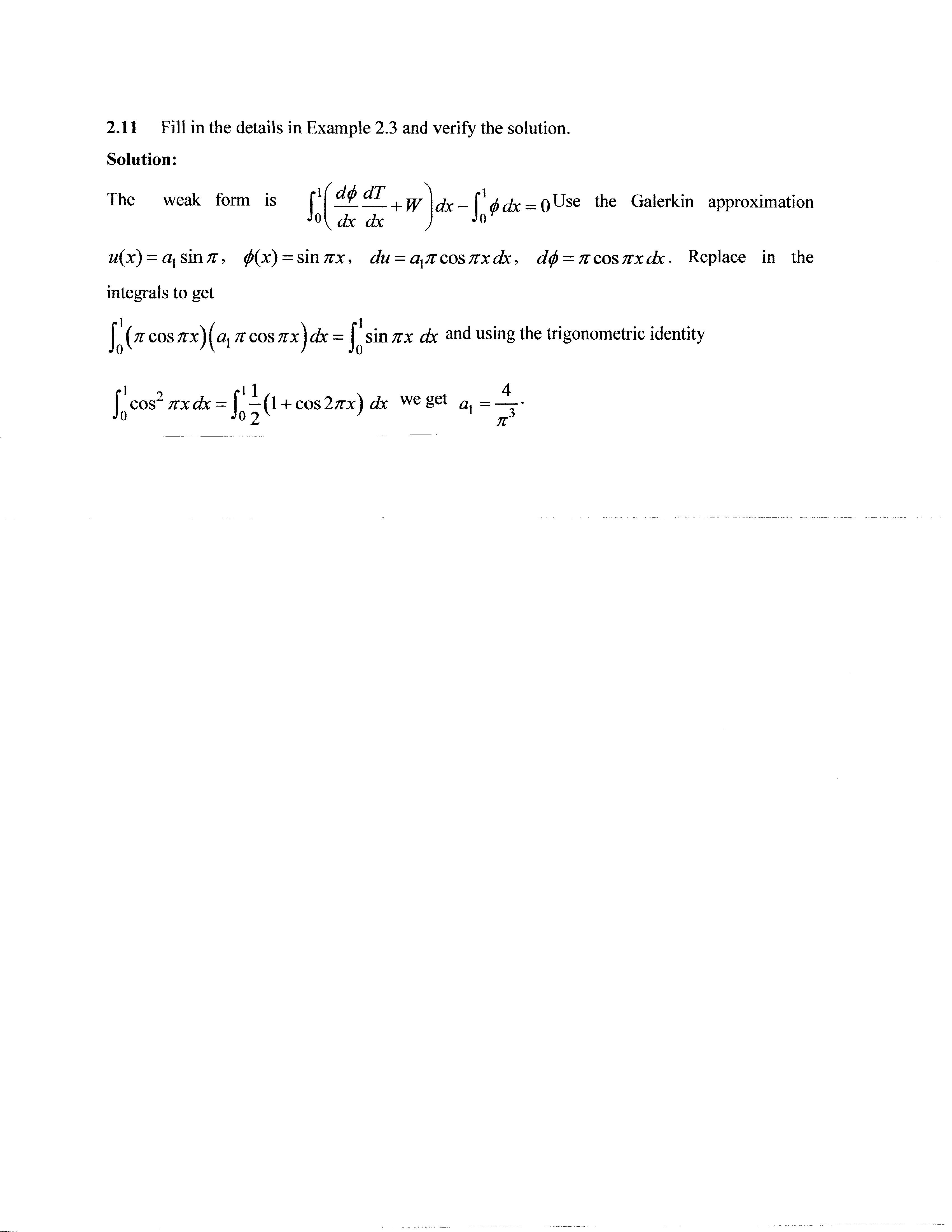
2.11 Fill inthe details in Example 2.3 and verify the solution
Solution:
The weak form is dx dx + W dx - <^dx = 0^^^ the Galerkin approximation J Jo
u(x) = (3j sin TT, ^(x) = sin TTX, du = a^7t cos Ttxdx, d(j> = n cos nx dx • Replace in the integrals to get
''^{n cos nx)[a\ cos nx^ ^ = sin nx dx and using the trigonometric identity
'^cos^;rxci^= f^-(l + cos2;rx)^ we get a^^—^ 0 Jo2^ ^ ^

2.12 Showthat if the expressions for cj), given by Eq. (2.20) are used in Eq. (2.19), then a, - Tf.
Solution:
Eq. 2.19 is T(x) = i^,ix)ai+<f'M(x)a,^, x,<x<x,^^ where ^ / ^ /„\ ^ -^i , and <^,+i(x)-
Substituting T{x) = - X X-X i „ and evaluating at the nodes "z+l
T(x,) = a^=T. and T(x^^,) = a,^, = T,^y
2.13 Find the weak formulation of Eq. (2.]) with the boundary condition

Solution:
The general form is given in Eq. 2.17 rLd(l>dT
Substituting Ld^dT the flux
2.14 Using two linear elements solve the equations in problem (2.13) with L = \ K = 200 w/mK, Q = 100 W/m\ - 150 W/m^K, = lOOC and q = 2,000 W/m'
Solution:
Using Eqs. 2.19 and 2.30 2K 1 - 1

> Substitute the
+ 0.0016667^
